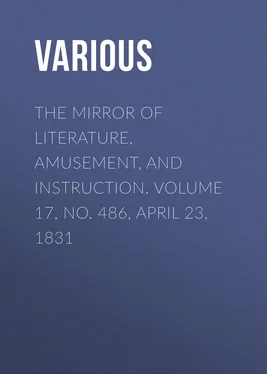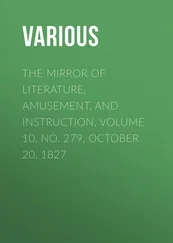Various - The Mirror of Literature, Amusement, and Instruction. Volume 17, No. 486, April 23, 1831
Здесь есть возможность читать онлайн «Various - The Mirror of Literature, Amusement, and Instruction. Volume 17, No. 486, April 23, 1831» — ознакомительный отрывок электронной книги совершенно бесплатно, а после прочтения отрывка купить полную версию. В некоторых случаях можно слушать аудио, скачать через торрент в формате fb2 и присутствует краткое содержание. Жанр: foreign_antique, periodic, Развлечения, foreign_edu, на английском языке. Описание произведения, (предисловие) а так же отзывы посетителей доступны на портале библиотеки ЛибКат.
- Название:The Mirror of Literature, Amusement, and Instruction. Volume 17, No. 486, April 23, 1831
- Автор:
- Жанр:
- Год:неизвестен
- ISBN:нет данных
- Рейтинг книги:5 / 5. Голосов: 1
-
Избранное:Добавить в избранное
- Отзывы:
-
Ваша оценка:
- 100
- 1
- 2
- 3
- 4
- 5
The Mirror of Literature, Amusement, and Instruction. Volume 17, No. 486, April 23, 1831: краткое содержание, описание и аннотация
Предлагаем к чтению аннотацию, описание, краткое содержание или предисловие (зависит от того, что написал сам автор книги «The Mirror of Literature, Amusement, and Instruction. Volume 17, No. 486, April 23, 1831»). Если вы не нашли необходимую информацию о книге — напишите в комментариях, мы постараемся отыскать её.
The Mirror of Literature, Amusement, and Instruction. Volume 17, No. 486, April 23, 1831 — читать онлайн ознакомительный отрывок
Ниже представлен текст книги, разбитый по страницам. Система сохранения места последней прочитанной страницы, позволяет с удобством читать онлайн бесплатно книгу «The Mirror of Literature, Amusement, and Instruction. Volume 17, No. 486, April 23, 1831», без необходимости каждый раз заново искать на чём Вы остановились. Поставьте закладку, и сможете в любой момент перейти на страницу, на которой закончили чтение.
Интервал:
Закладка:
Various
The Mirror of Literature, Amusement, and Instruction / Volume 17, No. 486, April 23, 1831
WINDSOR CASTLE
GEORGE THE FOURTH’S GATEWAY, FROM THE INTERIOR OF THE QUADRANGLE
We wish the reader to consider this Engraving as the first of a Series of Illustrations of Windsor Castle, in which it will be our aim to show how far the renovations lately completed or now in progress are likely to improve the olden splendour of this stupendous pile. This, we are persuaded, would be matter of interest at any time, but will be especially so during the coming summer and autumn, when, it is reasonable enough to expect that Windsor will double its number of curious visiters. During the late King’s reign, the Castle more resembled one wide, vast solitude than the abode of a numerous court. An occasional banquet enlivened its halls, though it only rendered more painful the solitariness by which it was succeeded. Affliction too broke in upon the life of the Royal tenant, and stripped regal state of all its mimic joys, till pain and long protracted suffering welcomed the happy sleep of death. An occupant of different tastes and habits has succeeded; domestic enjoyment has once more become the characteristic of the British court, and the Sovereign has cherished the affections of his people by admitting them to the enjoyment of certain privileges, which, though unimportant in themselves, have a grateful effect in identifying interests and considerations which were commonly considered as very remote. The terrace and slopes of the Castle have been thrown open to the public, the park grounds are no longer kept clear of visiters, and access to the Castle itself may be much more freely enjoyed than during the late reign. The King and the Queen may be seen daily in the real luxury of conjugal and domestic comfort. Plainness of purpose, and affectionate amiability of manners, have done much towards their popularity; and the love of a good and wise people cannot be better secured than by such fostering consideration from their rulers; nay, its paternal influence is but part and parcel of the grand scheme of civilization and society.
Proceeding to the details of the Print, we may observe that in our eleventh volume we gave three engravings illustrative of the Castle improvements; one of which represented the gateway named after the late Sovereign, and seen from the Long Walk . The present Engraving is the other side of the gateway, as seen from the interior of the square or quadrangle. This new gate was externally completed in 1826. The natural application of the fine avenue, called the Long Walk, was thus realized. The gateway consists of two towers the York and Lancaster. The foundations and walls of the York Tower were part of the old building—the Lancaster is entirely new. These towers which have machiolated battlements, are about 100 feet high; the gateway between them is 24 feet high. In our former Engraving, the gateway was in the distance, but the present being a near view, shows the solidity, largeness of proportions, and the boldness of the building, to greater advantage. The appearance of the whole is extremely beautiful, although its newness and cleanness remind us of Mr. Bowles’s eccentric observation, that “it looks as if it was washed every morning with soap and water .”
Here it may be as well to state that Windsor Castle is divided into the upper and lower wards. The lower contains the ecclesiastical portions of the edifice, including St. George’s Chapel. The upper ward is formed by the celebrated Round Tower on the west; the state apartments, including St. George’s Hall, on the north; and a range of domestic apartments on the east and south, which communicate with the state apartments. The whole building is thus a hollow square, of which the three outer sides on the north, east, and south, are surrounded with a magnificent terrace. The Inner Court, or Quadrangle, is a connected building of three sides, the fourth being formed by the Round Tower, or Keep.
The improvements of the interior of the Quadrangle having been already detailed by us, 1 1 See Mirror , vol. xi. p. 2.
we pass on to observe, that the low French windows of St. George’s Hall, which faces the side in our Engraving, have been replaced by long pointed arch windows, of elegant proportions. Nothing can exceed the splendour of the look-out from these windows through the arched entrance to the “lengthened vista,” or Long Walk, as shown in the Engraving. The interior of the Hall is nearly completed; “the length, 200 feet, is too great for the width;” 2 2 Athenæum , No. 180—an opinion to which we beg to subscribe.
the carved ceiling, and the arms of the Knights of the Garter, from the first institution of the order, are exquisitely emblazoned on shields or escutcheons. Beautifully as they are executed, we scarcely like their whole effect, which is undoubtedly marred by the proportions of the hall itself. Perhaps they are too near a blaze of chivalric splendour for these days of cold calculation. The ball-room, adjoining in St. George’s Hall, is nearly completed. The decorations are gold and white, in the florid style of the time of Louis the Fourteenth, superb and showy; four pieces of tapestry are let into the walls, which, observes the Athenæum , really look like some of Rubens’s stupendous works now in the Grosvenor collection. We have not seen these apartments since last summer, when the decorations were in a forward state. We were surprised at the coarseness of the gilding, when examined closely; we saw, too, that where one of the entrances to the Ball-room had been heightened, the original, door had been pieced , which was a work of economy we did not look for in the repairs of a palace.
It is gratifying to learn that the erection of a colossal statue of George III. on Snow Hill, in the Long Walk, is in progress. This is a testimony of the filial affection of the late King, and should not be overlooked in his character.
STERNE’S ELIZA
Though a perusal of your pages evidently shows that you wish more for original communications than to copy from any one, yet the extreme beauty of the following article (which I exactly copy as it appeared translated in the European Magazine for March, 1784) makes one hope to see it revived or preserved in the Mirror .
A CONSTANT READER.
“Mrs. DRAPER, the lady who has been so celebrated as the correspondent of Mr. STERNE, under the name of ELIZA, will naturally attract the notice of the Public. That she was deserving of the encomiums bestowed upon her by that admirable writer will appear from the following eulogium, written by the excellent Abbe RAYNAL, which I transmit to you for publication in your next Magazine.—I am yours, &c. A.T.
“Territory of Anjengo , 3 3 A town of Hindoostan, in Travancore.
thou art nothing; but thou hast given birth to Eliza. A day will come, when these staples of commerce, founded by the Europeans on the coasts of Asia, will exist no more. Before a few centuries are elapsed, the grass will cover them, or the Indians, avenged , will have built upon their ruins. But if my works be destined to have any duration, the name of Anjengo will not be obliterated from the memory of man. Those who shall read my works, or those whom the winds shall drive towards these shores, will say—There it is that Eliza Draper was born; and if there be a Briton among them, he will immediately add, with the spirit of conscious pride—And there it was that she was born of English parents.
“Let me be permitted to indulge my grief, and to give a free course to my tears! Eliza was my friend. Reader, whosoe’er thou art, forgive me this involuntary motion;—let my mind dwell upon Eliza. If I have sometimes moved thee to compassionate the calamities of the human race, let me now prevail upon thee to commiserate my own misfortune. I was thy friend without knowing thee; be for a moment mine. Thy gentle pity shall be my reward.
Читать дальшеИнтервал:
Закладка:
Похожие книги на «The Mirror of Literature, Amusement, and Instruction. Volume 17, No. 486, April 23, 1831»
Представляем Вашему вниманию похожие книги на «The Mirror of Literature, Amusement, and Instruction. Volume 17, No. 486, April 23, 1831» списком для выбора. Мы отобрали схожую по названию и смыслу литературу в надежде предоставить читателям больше вариантов отыскать новые, интересные, ещё непрочитанные произведения.
Обсуждение, отзывы о книге «The Mirror of Literature, Amusement, and Instruction. Volume 17, No. 486, April 23, 1831» и просто собственные мнения читателей. Оставьте ваши комментарии, напишите, что Вы думаете о произведении, его смысле или главных героях. Укажите что конкретно понравилось, а что нет, и почему Вы так считаете.












